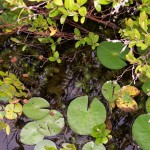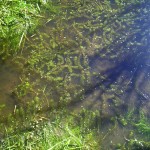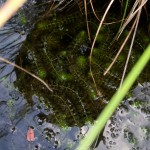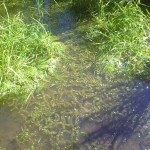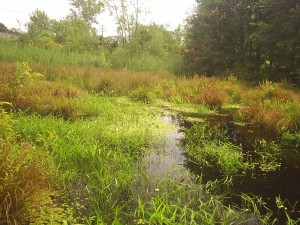Written By: Rich aka rsivertsen - Northwest New Jersey, (USA)
It’s taken me about 20 years to finally understand these plants; as simple as they may appear, they actually have a very complex symbiotic relationship with several other plants and organisms in a close knit niche, and without most, or all of these members present, in a very intimate and close proximity, the Aldrovanda will go into decline and die.
During my earlier years in attempting to grow them in various containers, I was convinced that there must be some magic formula to get the water chemistry just right so that they would grow as easily as most Utricularia do for me in cultivation, but time after time, the Aldrovanda would grow well initially for a few weeks, or months, but then start to go into decline, and eventually crash and die, most cases overwhelmed in some algae bloom.
I was also under the false impression that the pH was a factor, and that they required very “clean” acidic water. I also made the mistake of trying to grow them in containers that were too deep. I went through countless recipes of various broth mixes of peat, pine needles and oak leaves, bark, various other compost mixes, and pH adjusting additives, and including a UV filter to keep the water nearly sterile.
I look back now and realize that my earlier assumptions about Aldrovanda were totally ALL wrong!
First, it’s NOT the chemistry of the water so much as the Biology, in that all of the constituent members of this close knit symbiotic relationship are present, and active. The plants actually do better in water that tests neutral (pH=7.0), instead of acidic conditions! It also seems to do best where there is some clay in the detritus, and that clay and detritus is stirred up occasionally so that the water is a disgusting slurry of clay and detritus to the point where the strands are barely visible.
According to Lubomir Adamec, Aldrovanda’s most important essential requirement is CO2, which it needs for photosynthesis. This is produced by the respiration of large monocot plants’ extensive root system. CO2 out gasses directly upward and very quickly, as anyone knows who had left a carbonated beverage out in a glass too long, realizes that it’s gone flat. These roots need to be in very close proximity to the Aldrovanda, and directly beneath the strands, even exposed, and commingled with the Aldrovanda, otherwise the CO2 becomes too diluted, and dispersed, and useless to the Aldrovanda, which is one reason why they don’t grow well in water that’s too deep. The best strands grow in just a few inches of free standing water, in areas that look like someone’s over watered backyard lawn after a flooding rain storm, commingled with the grass-like plants that are anchored in the detritus, and rise above the water, and in full direct sunlight all day long. There are deeper areas in my ponds, that are “knee deep” or more, but there are no Aldrovanda strands in these spots, only those areas that are “ankle deep” or less.
This niche is also the areas that contains the highest population density of zooplankonic creatures, as they dwell in the detritus, but climb up on those grassy stems to get air, and oxygen rich water at the surface. Here a host of creatures from snails to copepods to mosquito larvae, even several worms, including tubiflex worms exist, many of which also groom the Aldrovanda strands feeding on any filamentous algae that might attack the stands, and also wind up as prey for the plants as well! This relationship with the zooplankton population is another critical factor for them, and becomes so powerful, that algae actually goes into decline and disappears within days near the Aldrovanda strands.
The Aldrovanda can only utilize a certain amount of the nitrogenous matter that it captures, and releases the excess back into the water; the large monocot plants are very heavy nitrogen feeders, and quickly absorb and assimilate this excess, and in return get a boost in growth, which accelerates CO2 production from their roots by respiration, a fully reciprocal (mutualism) symbiotic relationship. Without this balance, algae, being an opportunist, takes advantage of this and overwhelms everything to death.
The zooplankton community also benefits by having the Aldrovanda serve as an effective predator in order to keep their population in control, and in balance with the environment, by preventing the cyclic population explosions, resulting in collapse, followed by massive, killing algae blooms, and eutrophication. Aldrovanda is the only effective predator that can exist in these dystrophic small pools, that tend to be very low in oxygen, and dry out frequently; Aldrovanda is also one of the few aquatic plants that actually has a survival mechanism which enables it to survive being out of water for several weeks time. Aldrovanda also grows faster, and branches more often in direct response to the amount of prey that it captures, so that it can keep up with the exponential growth of the zooplakton community. In ideal conditions, Aldrovanda will at least double it’s population (apical growth points) every 5 to 7 days, which is why I advise not to grow them in home aquariums, but instead small and shallow pools outside with large companion monocot plants.
They can tolerate very warm, even hot water, which may be lethal for most fish, 95(F), (40C) is not unusual, and in fact, it is one of the factors that will cause them to produce flowers. In my ponds, if they have temps in the 90(F) for at least 2 weeks prior to the summer solstice (June 21), they will produce flowers in mid July, and often profusely at that!
Anyone wishing to grow these plants should frame out a shallow pond using either decorative block stone, or other materials, and rubberized pond liner, leaving only about a foot deep for water, fill it with water obtained from a local lake or pond, and harvesting as much mud and detritus as possible. Then get some decorative grasses, and grass-like plants such as Carex, Juncus, Typha, Papyra, etc, and when you can see the roots spreading out from the bottom of the pots, (if you prefer to keep them in their pots), then you can introduce some Aldrovanda near these plants, where they can recieve as much direct sunlight as possible. Perhaps some guppies and other fish may be introduced as well. I would also recommend adding some clay to the detritus mix, and even add some live tubliflex worms; in the last photos below, Aldrovanda is growing in just a few inches of water, in a clat bed with mats of tubiflex worms dancing just below the strands, and releasing their CO2 by respiration.

